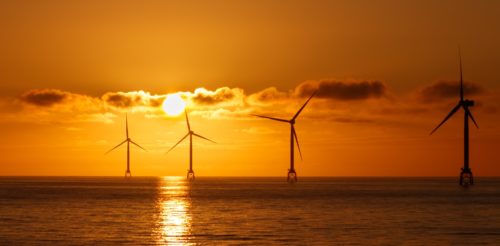Green energy in sunrise

A New Dawn
Today, the inauguration of the Biden-Harris Administration begins a new chapter in history, with the opportunity to look toward the far horizon of potential progress. As one of his first executive orders, President Biden has recommitted the United States to the Paris Agreement. Federal leadership in Washington, D.C., will now support and enhance the climate-focused ambition and action from sub-federal and non-state actors, which through We Are Still In and America’s Pledge have been working to continue cutting emissions despite the last four years of federal obstruction.
In doing so, our nation can now return to the international community where major countries are shifting into high gear on the clean energy transition. Although we are starting from behind, we may still race to catch up with other global leaders.
For too long, the idea that we transition our energy economy away from fossil fuels to the low-carbon solutions of the future has been seen as a burden, not an opportunity. But over the past years, that calculus has dramatically changed. One after another, the clean energy solutions of the future are becoming competitive. Energy efficiency was always a good way to drive productivity. Wind and solar are now beating coal and gas as the most cost-effective way to produce power. In the next four years, EVs will become cheaper, upfront, than traditional cars. Across the board, the future energy economy is made up of clean solutions driving an industrial revolution not seen before.
In order to catch up in this transition, the United States will need a robust industrial policy—a coordinated plan for the development of the US energy economy—that prioritizes the new technologies that are gaining ground, not the high-carbon technologies of the past. Not only can such an industrial policy put our country on the right path toward accelerating the clean energy transition, it can also create millions of good jobs, improve health outcomes, enhance security, build critical infrastructure, and drive economic competitiveness, among other benefits.
“Industrial policy” is not a phrase that you hear often in US policy circles. Industrial policy thinking is often derided as “a statist approach” or even worse as “socialists picking winners.” But when so much is changing so fast there is a lot to be said for an economy-wide plan to protect and advance US industrial competitiveness in the energy arena. And just as industrial policy is a core part of the planning in other nations, in earlier decades the US federal government used ambitious policies to build much of the infrastructure which forms the basis for our economy—from the interstate highway system to the internet.
Building on a History of Success
This process has historically been accelerated by forming successful public-private partnerships leveraging government resources paired with industry expertise to more rapidly drive progress. It is time to revisit that approach. The incoming Biden administration has a unique opportunity to leverage the COVID recovery with a green stimulus package that drives industrial transformation in critical areas of the economy. With a public-private partnership model, the administration can deploy government stimulus funding to strategically drive more rapid industrial transformation. This strategic use of government funding and coordinating power can create economic benefits many times larger than the initial investment, leading to global advantage for decades.
For example, faced with growing competition from Japan, the US semiconductor industry in 1988 created Sematec. This consortium of 14 American chip manufacturers including Intel and Texas Instruments was formed with the aim of revitalizing the industry by reducing manufacturing costs and product defects. Sematec was led by the private sector but had the blessing of and received funding from the federal government.
Before Sematech was created, it took 30 percent more research and development funding to create each new generation of chip miniaturization. That dropped to 12.5 percent shortly after the creation of Sematech and then into the low single digits. Also significantly, Sematech achieved the goal of compressing miniaturization cycles from three years to two, speeding innovation throughout the electronics industry and the entire economy.
Applying this model to energy innovation, the US Department of Energy created the Advanced Research Projects Agency for Energy (ARPA-E) program, designed after the DARPA system for the Department of Defense that achieved such notable successes as GPS and the fighter jet. ARPA-E has supported hundreds of earlier stage energy innovation efforts, many of which continue down the commercialization pathway to receive support from national labs, incubators, accelerators, investors, and corporate partners.
In the aftermath of the 2009 financial crisis, the government also put in place a clean energy loan guarantee program that helped kick-start many of the cleantech success stories in the United States, including Tesla, and returned net benefits to taxpayers. Tragically, these wins were largely overlooked due to “Solyndra talking points” from some political circles.
Strategic Energy Leadership Is Needed
But despite the success of these programs, and the need for a strategic approach to energy leadership in a changing market, for the past few decades much of our federal policy has unfortunately stopped at support for R&D. It has not prioritized retaining manufacturing for the products based on breakthroughs in US labs. In both the solar and battery industries, after spending billions to develop cutting-edge technologies, the United States has ceded leadership. We have also not supported the build-out of crucial infrastructure, such as upgrades to our transmission system. And above all, energy policy has not been based on a comprehensive and shared vision and pro-active strategy for leading the global energy transition.
Countries around the world are quickly surpassing the United States in building the energy systems of the future, from high-speed rail and solar panels to offshore wind turbines. China now dominates solar and lithium-ion battery manufacturing. Europe has achieved global dominance in the offshore wind industry, among others, by following a public-private partnership model called the Offshore Wind Accelerator (OWA). OWA partners include E.ON, EnBW, Ørsted, Statoil and Vattenfall, Fistuca, Van Oord, Shell and Sif, in addition to support from the Netherlands Enterprise Agency. China, Europe, and Japan all have sophisticated industrial policies that will give their companies a significant comparative advantage if met by an uncoordinated US response.
The US response to the loss of clean energy competitiveness has been accompanied by an ideological attachment to defending the technologically neutral mantra of an “all of the above” energy policy. We have imposed import tariffs that drove up the cost of solar, instead of proactive policies to focus on nurturing and retaining solar manufacturing and other industries of the future. If we do not quickly begin catching up, we will find that our nation is ill-equipped to face the challenges of the coming decades and miss the potential for incredible growth. It is as though we have told the world that we will continue to bet on typewriter manufacturing, just as the personal computer is coming of age.
Business leaders increasingly understand the shifting dynamic in the energy economy and are eager to seize opportunities in areas such as electric vehicles, renewable energy, transmission, high-speed rail, electrifying buildings, and decarbonizing industries like shipping, aviation, steel, and cement. They also have come to grips with the risks associated with inaction, both physical risk from climate change and the transition risk from the impending energy revolution. The potential for growth across the entire economy is enormous, as we work to drive all sectors more rapidly toward zero-emissions solutions.
The Course Toward a Sustainable Energy Future
There are three things we must do as a nation to seize the opportunity of a sustainable energy future: agree on a vision, leave ideology behind, and work to ensure a just transition for all. We must start by accepting the facts about the direction we are traveling: the future lies in clean, electric solutions and not in fossil fuels.
Once we have set our course together, we can work together collaboratively and quickly to accelerate progress and to set policies that allow the United States to really lead in the industries of the future. Finally, the benefits of these solutions can be more evenly distributed across all communities, providing people everywhere with lower energy costs, better jobs, improved health, enhanced resilience and security, and more.
Today, a ray of hope breaks through over the National Mall in Washington. A new administration will help set the course toward a sustainable energy future. Together, we can quickly move toward this future, and through this enable a strong recovery, a revitalized economy, and a collaborative global response to the climate crisis. If we unite as a nation and with others around the world, we can solve many challenges at once and build a better, cleaner, more prosperous future for all.

